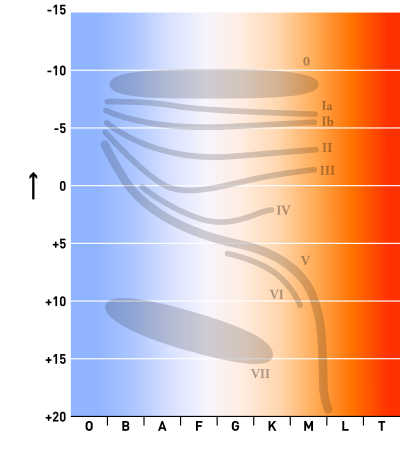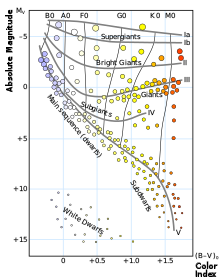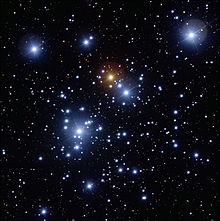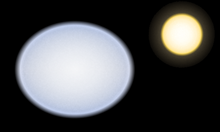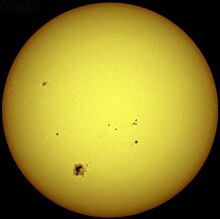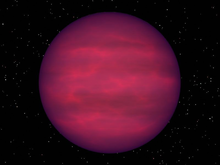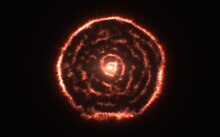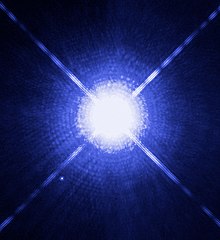Classification of stars from O-M
In astronomy, stellar classification is the classification of stars based on their spectral characteristics. Electromagnetic radiation from the star is analyzed by splitting it with a prism or diffraction grating into a spectrum exhibiting the rainbow of colors interspersed with spectral lines. Each line indicates a particular chemical element or molecule,
with the line strength indicating the abundance of that element. The
strengths of the different spectral lines vary mainly due to the
temperature of the photosphere, although in some cases there are true abundance differences. The spectral class of a star is a short code primarily summarizing the ionization state, giving an objective measure of the photosphere's temperature.
Most stars are currently classified under the Morgan-Keenan (MK) system using the letters O, B, A, F, G, K, and M, a sequence from the hottest (O type) to the coolest (M type). Each letter class is then subdivided using a numeric digit with 0 being hottest and 9
being coolest (e.g. A8, A9, F0, and F1 form a sequence from hotter to
cooler). The sequence has been expanded with classes for other stars and
star-like objects that do not fit in the classical system, such as
class D for white dwarfs and classes S and C for carbon stars.
In the MK system, a luminosity class is added to the spectral class using Roman numerals.
This is based on the width of certain absorption lines in the star's
spectrum, which vary with the density of the atmosphere and so
distinguish giant stars from dwarfs. Luminosity class 0 or Ia+ is used for hypergiants, class I for supergiants, class II for bright giants, class III for regular giants, class IV for sub-giants, class V for main-sequence stars, class sd (or VI) for sub-dwarfs, and class D (or VII) for white dwarfs. The full spectral class for the Sun is then G2V, indicating a main-sequence star with a surface temperature around 5,800 K.
Conventional color description
Just-saturated RGB-camera discs
The conventional color description takes into account only the peak
of the stellar spectrum. In actuality, however, stars radiate in all
parts of the spectrum. Because all spectral colors combined appear
white, the actual apparent colors the human eye would observe are far
lighter than the conventional color descriptions would suggest. This
characteristic of 'lightness' indicates that the simplified assignment
of colors within the spectrum can be misleading. Excluding
color-contrast illusions in dim light, there are no green, indigo, or
violet stars. Red dwarfs are a deep shade of orange, and brown dwarfs do not literally appear brown, but hypothetically would appear dim grey to a nearby observer.
Modern classification
The Morgan–Keenan spectral classification
The modern classification system is known as the Morgan–Keenan
(MK) classification. Each star is assigned a spectral class from the
older Harvard spectral classification and a luminosity class using Roman
numerals as explained below, forming the star's spectral type.
Other modern stellar classification systems, such as the UBV system, are based on color indexes—the measured differences in three or more color magnitudes. Those numbers are given labels such as "U-V" or "B-V", which represent the colors passed by two standard filters (e.g. Ultraviolet, Blue and Visual).
Harvard spectral classification
The Harvard system is a one-dimensional classification scheme by astronomer Annie Jump Cannon,
who re-ordered and simplified a prior alphabetical system. Stars are
grouped according to their spectral characteristics by single letters of
the alphabet, optionally with numeric subdivisions. Main-sequence stars
vary in surface temperature from approximately 2,000 to 50,000 K,
whereas more-evolved stars can have temperatures above 100,000 K.
Physically, the classes indicate the temperature of the star's
atmosphere and are normally listed from hottest to coldest.
The Hertzsprung–Russell diagram relates stellar classification with absolute magnitude, luminosity, and surface temperature.
The spectral classes O through M, as well as other more specialized classes discussed later, are subdivided by Arabic numerals
(0–9), where 0 denotes the hottest stars of a given class. For example,
A0 denotes the hottest stars in class A and A9 denotes the coolest
ones. Fractional numbers are allowed; for example, the star Mu Normae is classified as O9.7. The Sun is classified as G2.
Conventional color descriptions are traditional in astronomy, and
represent colors relative to the mean color of an A class star, which
is considered to be white. The apparent color
descriptions are what the observer would see if trying to describe the
stars under a dark sky without aid to the eye, or with binoculars.
However, most stars in the sky, except the brightest ones, appear white
or bluish white to the unaided eye because they are too dim for color
vision to work. Red supergiants are cooler and redder than dwarfs of the
same spectral type, and stars with particular spectral features such as
carbon stars may be far redder than any black body.
The fact that the Harvard classification of a star indicated its surface or photospheric temperature (or more precisely, its effective temperature) was not fully understood until after its development, though by the time the first Hertzsprung–Russell diagram was formulated (by 1914), this was generally suspected to be true. In the 1920s, the Indian physicist Meghnad Saha
derived a theory of ionization by extending well-known ideas in
physical chemistry pertaining to the dissociation of molecules to the
ionization of atoms. First he applied it to the solar chromosphere, then
to stellar spectra.
Harvard astronomer Cecilia Payne then demonstrated that the O-B-A-F-G-K-M spectral sequence is actually a sequence in temperature.
Because the classification sequence predates our understanding that it
is a temperature sequence, the placement of a spectrum into a given
subtype, such as B3 or A7, depends upon (largely subjective) estimates
of the strengths of absorption features in stellar spectra. As a result,
these subtypes are not evenly divided into any sort of mathematically
representable intervals.
Yerkes spectral classification
Montage of false color spectra for main sequence stars
The Yerkes spectral classification, also called the MKK system from the authors' initials, is a system of stellar spectral classification introduced in 1943 by William Wilson Morgan, Philip C. Keenan, and Edith Kellman from Yerkes Observatory. This two-dimensional (temperature and luminosity) classification scheme is based on spectral lines sensitive to stellar temperature and surface gravity, which is related to luminosity (whilst the Harvard classification
is based on just surface temperature). Later, in 1953, after some
revisions of list of standard stars and classification criteria, the
scheme was named the Morgan–Keenan classification, or MK, and this system remains in use.
Denser stars with higher surface gravity exhibit greater pressure broadening of spectral lines. The gravity, and hence the pressure, on the surface of a giant star is much lower than for a dwarf star
because the radius of the giant is much greater than a dwarf of similar
mass. Therefore, differences in the spectrum can be interpreted as luminosity effects and a luminosity class can be assigned purely from examination of the spectrum.
A number of different luminosity classes are distinguished, as listed in the table below.
| Luminosity class | Description | Examples |
|---|---|---|
| 0 or Ia+ | hypergiants or extremely luminous supergiants | Cygnus OB2#12 – B3-4Ia+ |
| Ia | luminous supergiants | Eta Canis Majoris – B5Ia |
| Iab | intermediate-size luminous supergiants | Gamma Cygni – F8Iab |
| Ib | less luminous supergiants | Zeta Persei – B1Ib |
| II | bright giants | Beta Leporis – G0II |
| III | normal giants | Arcturus – K0III |
| IV | subgiants | Gamma Cassiopeiae – B0.5IVpe |
| V | main-sequence stars (dwarfs) | Achernar – B6Vep |
| sd (prefix) or VI | subdwarfs | HD 149382 – sdB5 or B5VI |
| D (prefix) or VII | white dwarfs [c] | van Maanen 2 – DZ8 |
Marginal cases are allowed; for example, a star may be either a
supergiant or a bright giant, or may be in between the subgiant and
main-sequence classifications.
In these cases, two special symbols are used:
- A slash (/) means that a star is either one class or the other.
- A dash (-) means that the star is in between the two classes.
For example, a star classified as A3-4III/IV would be in between
spectral types A3 and A4, while being either a giant star or a subgiant.
Sub-dwarf classes have also been used: VI for sub-dwarfs (stars slightly less luminous than the main sequence).
Nominal luminosity class VII (and sometimes higher numerals) is
now rarely used for white dwarf or "hot sub-dwarf" classes, since the
temperature-letters of the main sequence and giant stars no longer apply
to white dwarfs.
Occasionally, letters a and b are applied to
luminosity classes other than supergiants; for example, a giant star
slightly more luminous than typical may be given a luminosity class of
IIIb.
A sample of extreme V stars with strong absorption in He II λ4686 spectral lines have been given the Vz designation. An example star is HD 93129 B.
Spectral peculiarities
Additional
nomenclature, in the form of lower-case letters, can follow the
spectral type to indicate peculiar features of the spectrum.
| Code | Spectral peculiarities for stars |
|---|---|
| : | uncertain spectral value |
| ... | Undescribed spectral peculiarities exist |
| ! | Special peculiarity |
| comp | Composite spectrum |
| e | Emission lines present |
| [e] | "Forbidden" emission lines present |
| er | "Reversed" center of emission lines weaker than edges |
| eq | Emission lines with P Cygni profile |
| f | N III and He II emission |
| f* | N IV λ4058Å is stronger than the N III λ4634Å, λ4640Å, & λ4642Å lines |
| f+ | Si IV λ4089Å & λ4116Å are emitted, in addition to the N III line |
| (f) | N III emission, absence or weak absorption of He II |
| (f+) | |
| ((f)) | Displays strong He II absorption accompanied by weak N III emissions |
| ((f*)) | |
| h | WR stars with hydrogen emission lines. |
| ha | WR stars with hydrogen seen in both absorption and emission. |
| He wk | Weak Helium lines |
| k | Spectra with interstellar absorption features |
| m | Enhanced metal features |
| n | Broad ("nebulous") absorption due to spinning |
| nn | Very broad absorption features |
| neb | A nebula's spectrum mixed in |
| p | Unspecified peculiarity, peculiar star. |
| pq | Peculiar spectrum, similar to the spectra of novae |
| q | P Cygni profiles |
| s | Narrow ("sharp") absorption lines |
| ss | Very narrow lines |
| sh | Shell star features |
| var | Variable spectral feature (sometimes abbreviated to "v") |
| wl | Weak lines (also "w" & "wk") |
| Element symbol |
Abnormally strong spectral lines of the specified element(s) |
For example, 59 Cygni is listed as spectral type B1.5Vnne, indicating a spectrum with the general classification B1.5V, as well as very broad absorption lines and certain emission lines.
Guide for Secchi spectral types ("152 Schjellerup" is Y Canum Venaticorum)
History
The
reason for the odd arrangement of letters in the Harvard classification
is historical, having evolved from the earlier Secchi classes and been
progressively modified as understanding improved.
Secchi classes
During the 1860s and 1870s, pioneering stellar spectroscopist Angelo Secchi created the Secchi classes in order to classify observed spectra. By 1866, he had developed three classes of stellar spectra, shown in the table below.
In the late 1890s, this classification began to be superseded by
the Harvard classification, which is discussed in the remainder of this
article.
| Class number | Secchi class description |
|---|---|
| Secchi class I | White and blue stars with broad heavy hydrogen lines, such as Vega and Altair. This includes the modern class A and early class F. |
| Secchi class I (Orion subtype) |
A subtype of Secchi class I with narrow lines in place of wide bands, such as Rigel and Bellatrix. In modern terms, this corresponds to early B-type stars |
| Secchi class II | Yellow stars – hydrogen less strong, but evident metallic lines, such as the Sun, Arcturus, and Capella. This includes the modern classes G and K as well as late class F. |
| Secchi class III | Orange to red stars with complex band spectra, such as Betelgeuse and Antares. This corresponds to the modern class M. |
| Secchi class IV | In 1868, he discovered carbon stars, which he put into a distinct group: Red stars with significant carbon bands and lines, corresponding to modern classes C and S. |
| Secchi class V | In 1877, he added a fifth class: Emission-line stars, such as Gamma Cassiopeiae and Sheliak, which are in modern class Be. In 1891, Edward Charles Pickering proposed that class V should correspond to the modern class O (which then included Wolf-Rayet stars) and stars within planetary nebulae. |
The Roman numerals
used for Secchi classes should not be confused with the completely
unrelated Roman numerals used for Yerkes luminosity classes and the
proposed neutron star classes.
Draper system
| Secchi | Draper | Comment |
|---|---|---|
| I | A, B, C, D | Hydrogen lines dominant. |
| II | E, F, G, H, I, K, L |
|
| III | M |
|
| IV | N | Did not appear in the catalogue. |
| V | O | Included Wolf–Rayet spectra with bright lines. |
| V | P | Planetary nebulae. |
| Q | Other spectra. | |
| Classes carried through into the MK system are in bold. | ||
In the 1880s, the astronomer Edward C. Pickering began to make a survey of stellar spectra at the Harvard College Observatory, using the objective-prism method. A first result of this work was the Draper Catalogue of Stellar Spectra, published in 1890. Williamina Fleming classified most of the spectra in this catalogue.
The catalogue used a scheme in which the previously used Secchi
classes (I to V) were subdivided into more specific classes, given
letters from A to P. Also, the letter Q was used for stars not fitting
into any other class.
Harvard system
In 1897, another worker at Harvard, Antonia Maury,
placed the Orion subtype of Secchi class I ahead of the remainder of
Secchi class I, thus placing the modern type B ahead of the modern
type A. She was the first to do so, although she did not use lettered
spectral types, but rather a series of twenty-two types numbered from I
to XXII.
In 1901, Annie Jump Cannon
returned to the lettered types, but dropped all letters except O, B, A,
F, G, K, M, and N used in that order, as well as P for planetary
nebulae and Q for some peculiar spectra. She also used types such as B5A
for stars halfway between types B and A, F2G for stars one-fifth of the
way from F to G, and so on. Finally, by 1912, Cannon had changed the types B, A, B5A, F2G, etc. to B0, A0, B5, F2, etc. This is essentially the modern form of the Harvard classification system.
A common mnemonic for remembering the order of the spectral type letters, from hottest to coolest, is "Oh, Be A Fine Guy/Girl, Kiss Me".
Mount Wilson classes
A luminosity classification known as the Mount Wilson system was used to distinguish between stars of different luminosities. This notation system is still sometimes seen on modern spectra.
| Class | Meaning |
|---|---|
| sd | Subdwarf |
| d | Dwarf |
| sg | Subgiant |
| g | Giant |
| c | Supergiant |
Spectral types
The stellar classification system is taxonomic, based on type specimens, similar to classification of species in biology:
The categories are defined by one or more standard stars for each
category and sub-category, with an associated description of the
distinguishing features.
"Early" and "late" nomenclature
Stars are often referred to as early or late types. "Early" is a synonym for hotter, while "late" is a synonym for cooler.
Depending on the context, "early" and "late" may be absolute or
relative terms. "Early" as an absolute term would therefore refer to O
or B, and possibly A stars. As a relative reference it relates to stars
hotter than others, such as "early K" being perhaps K0, K1, and K3.
"Late" is used in the same way, with an unqualified use of the
term indicating stars with spectral types such as K and M, but it can
also be used for stars that are cool relative to other stars, as in
using "late G" to refer to G7, G8, and G9.
In the relative sense, "early" means a lower Arabic numeral following the class letter, and "late" means a higher number.
This obscure terminology is a hold-over from an early
20th century model of stellar evolution, which supposed that stars were
powered by gravitational contraction via the Kelvin–Helmholtz mechanism, which is now known to not apply to main sequence
stars. If that were true, then stars would start their lives as very
hot "early-type" stars and then gradually cool down into "late-type"
stars. This mechanism provided ages of the Sun that were much smaller than what is observed in the geologic record, and was rendered obsolete by the discovery that stars are powered by nuclear fusion. The terms "early" and "late" were carried over, beyond the demise of the model they were based on.
Class O
The spectrum of an O5V star.
O-type stars are very hot and extremely luminous, with most of their radiated output in the ultraviolet
range. These are the rarest of all main-sequence stars. About 1 in
3,000,000 (0.00003%) of the main-sequence stars in the solar
neighborhood are O-type stars. Some of the most massive stars
lie within this spectral class. O-type stars frequently have
complicated surroundings that make measurement of their spectra
difficult.
O-type spectra formerly were defined by the ratio of the strength of the He II λ4541 relative to that of He I λ4471, where λ is the wavelength, measured in ångströms.
Spectral type O7 was defined to be the point at which the two
intensities are equal, with the He I line weakening towards earlier
types. Type O3 was, by definition, the point at which said line
disappears altogether, although it can be seen very faintly with modern
technology. Due to this, the modern definition uses the ratio of the nitrogen line N IV λ4058 to N III λλ4634-40-42.
O-type stars have dominant lines of absorption and sometimes emission for He II lines, prominent ionized (Si IV, O III, N III, and C III) and neutral helium lines, strengthening from O5 to O9, and prominent hydrogen Balmer lines,
although not as strong as in later types. Because they are so massive,
O-type stars have very hot cores and burn through their hydrogen fuel
very quickly, so they are the first stars to leave the main sequence.
When the MKK classification scheme was first described in 1943, the only subtypes of class O used were O5 to O9.5. The MKK scheme was extended to O9.7 in 1971 and O4 in 1978, and new classification schemes that add types O2, O3, and O3.5 have subsequently been introduced.
Spectral standards:
- O7V – S Monocerotis
- O9V – 10 Lacertae
Class B
B-class stars in the Jewel Box cluster (Credit: ESO VLT)
B-type stars are very luminous and blue. Their spectra have neutral
helium lines, which are most prominent at the B2 subclass, and moderate
hydrogen lines. As O- and B-type stars
are so energetic, they only live for a relatively short time. Thus, due
to the low probability of kinematic interaction during their lifetime,
they are unable to stray far from the area in which they formed, apart
from runaway stars.
The transition from class O to class B was originally defined to be the point at which the He II
λ4541 disappears. However, with modern equipment, the line is still
apparent in the early B-type stars. Today for main-sequence stars, the
B-class is instead defined by the intensity of the He I violet spectrum,
with the maximum intensity corresponding to class B2. For supergiants,
lines of silicon
are used instead; the Si IV λ4089 and Si III λ4552 lines are indicative
of early B. At mid B, the intensity of the latter relative to that of
Si II λλ4128-30 is the defining characteristic, while for late B, it is
the intensity of Mg II λ4481 relative to that of He I λ4471.
These stars tend to be found in their originating OB associations, which are associated with giant molecular clouds. The Orion OB1 association occupies a large portion of a spiral arm of the Milky Way and contains many of the brighter stars of the constellation Orion. About 1 in 800 (0.125%) of the main-sequence stars in the solar neighborhood are B-type main-sequence stars.
Massive yet non-supergiant entities known as "Be stars" are main-sequence stars that notably have, or had at some time, one or more Balmer lines in emission, with the hydrogen-related electromagnetic radiation series projected out by the stars being of particular interest. Be stars are generally thought to feature unusually strong stellar winds, high surface temperatures, and significant attrition of stellar mass as the objects rotate at a curiously rapid rate. Objects known as "B(e)" or "B[e]" stars possess distinctive neutral or low ionisation emission lines that are considered to have 'forbidden mechanisms', undergoing processes not normally allowed under current understandings of quantum mechanics.
Spectral standards:
- B0V – Upsilon Orionis
- B0Ia – Alnilam
- B2Ia – Chi2 Orionis
- B2Ib – 9 Cephei
- B3V – Eta Ursae Majoris
- B3V – Eta Aurigae
- B3Ia – Omicron2 Canis Majoris
- B5Ia – Eta Canis Majoris
- B8Ia – Rigel
Class A
Class A Vega (left) compared to the Sun (right).
A-type stars are among the more common naked eye stars, and are white
or bluish-white. They have strong hydrogen lines, at a maximum by A0,
and also lines of ionized metals (Fe II, Mg II, Si II) at a maximum at A5. The presence of Ca II
lines is notably strengthening by this point. About 1 in 160 (0.625%)
of the main-sequence stars in the solar neighborhood are A-type stars.
Spectral standards:
- A0Van – Gamma Ursae Majoris
- A0Va – Vega
- A0Ib – Eta Leonis
- A0Ia – HD 21389
- A1V – Sirius A
- A2Ia – Deneb
- A3Va – Fomalhaut
Class F
Canopus, an F-type supergiant and the second brightest star in the night sky
F-type stars have strengthening spectral lines H and K of Ca II. Neutral metals (Fe I, Cr I)
beginning to gain on ionized metal lines by late F. Their spectra are
characterized by the weaker hydrogen lines and ionized metals. Their
color is white. About 1 in 33 (3.03%) of the main-sequence stars in the
solar neighborhood are F-type stars.
Spectral standards:
- F0IIIa – Zeta Leonis
- F0Ib – Alpha Leporis
- F2V – 78 Ursae Majoris
Class G
The Sun, a G2 main-sequence star, with dark sunspots
G-type stars, including the Sun, have prominent spectral lines H and K of Ca II,
which are most pronounced at G2. They have even weaker hydrogen lines
than F, but along with the ionized metals, they have neutral metals.
There is a prominent spike in the G band of CH
molecules. Class G main-sequence stars make up about 7.5%, nearly one
in thirteen, of the main-sequence stars in the solar neighborhood.
Class G contains the "Yellow Evolutionary Void". Supergiant stars often swing between O or B (blue) and K or M (red). While they do this, they do not stay for long in the yellow supergiant G class, as this is an extremely unstable place for a supergiant to be.
Spectral standards:
- G0V – Beta Canum Venaticorum
- G0IV – Eta Boötis
- G0Ib – Beta Aquarii
- G2V – Sun
- G5V – Kappa Ceti
- G5IV – Mu Herculis
- G5Ib – 9 Pegasi
- G8V – 61 Ursae Majoris
- G8IV – Beta Aquilae
- G8IIIa – Kappa Geminorum
- G8IIIab – Epsilon Virginis
- G8Ib – Epsilon Geminorum
Class K
K-type stars are orangish stars that are slightly cooler than the
Sun. They make up about 12% of the main-sequence stars in the solar
neighborhood. There are also giant K-type stars, which range from hypergiants like RW Cephei, to giants and supergiants, such as Arcturus, whereas orange dwarfs, like Alpha Centauri B, are main-sequence stars.
They have extremely weak hydrogen lines, if those are present at all, and mostly neutral metals (Mn I, Fe I, Si I). By late K, molecular bands of titanium oxide
become present. There is a suggestion that K-spectrum stars may
potentially increase the chances of life developing on orbiting planets
that are within the habitable zone.
Spectral standards:
- K0V – Sigma Draconis
- K0III – Pollux
- K0III – Epsilon Cygni
- K2V – Epsilon Eridani
- K2III – Kappa Ophiuchi
- K3III – Rho Boötis
- K5V – 61 Cygni A
- K5III – Gamma Draconis
Class M
UY Scuti, an M4 supergiant
Class M stars are by far the most common. About 76% of the main-sequence stars in the solar neighborhood are class M stars. However, class M main-sequence stars (red dwarfs)
have such low luminosities that none are bright enough to be seen with
the unaided eye, unless under exceptional conditions. The brightest
known M-class main-sequence star is M0V Lacaille 8760, with magnitude
6.6 (the limiting magnitude for typical naked-eye visibility under good
conditions is typically quoted as 6.5), and it is extremely unlikely
that any brighter examples will be found.
Although most class M stars are red dwarfs, most of the largest ever supergiant stars in the Milky Way are M stars, such as VV Cephei, Antares, and Betelgeuse, which are also class M. Furthermore, the larger, hotter brown dwarfs are late class M, usually in the range of M6.5 to M9.5.
The spectrum of a class M star contains lines from oxide molecules (in the visible spectrum, especially TiO)
and all neutral metals, but absorption lines of hydrogen are usually
absent. TiO bands can be strong in class M stars, usually dominating
their visible spectrum by about M5. Vanadium(II) oxide bands become present by late M.
Spectral standards:
- M0IIIa – Beta Andromedae
- M2III – Chi Pegasi
- M1-M2Ia-Iab – Betelgeuse
- M2Ia – Mu Cephei
Extended spectral types
A number of new spectral types have been taken into use from newly discovered types of stars.
Hot blue emission star classes
UGC 5797, an emission-line galaxy where massive bright blue stars are formed
Spectra of some very hot and bluish stars exhibit marked emission lines from carbon or nitrogen, or sometimes oxygen.
Class W: Wolf–Rayet
Hubble Space Telescope image of the nebula M1-67 and the Wolf–Rayet star WR 124 in the center
Once included as type O stars, the Wolf-Rayet stars
of class W or WR are notable for spectra lacking hydrogen lines.
Instead their spectra are dominated by broad emission lines of highly
ionized helium, nitrogen, carbon, and sometimes oxygen. They are thought
to mostly be dying supergiants with their hydrogen layers blown away by
stellar winds,
thereby directly exposing their hot helium shells. Class W is further
divided into subclasses according to the relative strength of nitrogen
and carbon emission lines in their spectra (and outer layers).
WR spectra range is listed below:
- WN – spectrum dominated by N III-V and He I-II lines
- WNE (WN2 to WN5 with some WN6) – hotter or "early"
- WNL (WN7 to WN9 with some WN6) – cooler or "late"
- Extended WN classes WN10 and WN11 sometimes used for the Ofpe/WN9 stars
- h tag used (e.g. WN9h) for WR with hydrogen emission and ha (e.g. WN6ha) for both hydrogen emission and absorption
- WN/C – WN stars plus strong C IV lines, intermediate between WN and WC stars
- WC – spectrum with strong C II-IV lines
- WCE (WC4 to WC6) – hotter or "early"
- WCL (WC7 to WC9) – cooler or "late"
- WO (WO1 to WO4) – strong O VI lines, extremely rare
Although the central stars of most planetary nebulae (CSPNe) show O type spectra, around 10% are hydrogen-deficient and show WR spectra.
These are low-mass stars and to distinguish them from the massive
Wolf-Rayet stars, their spectra are enclosed in square brackets: e.g.
[WC]. Most of these show [WC] spectra, some [WO], and very rarely [WN].
The "Slash" stars
The slash stars are O-type stars with WN-like lines in their
spectra. The name "slash" comes from their printed spectral type having a
slash in it (e.g. "Of/WNL").
There is a secondary group found with this spectra, a cooler, "intermediate" group designated "Ofpe/WN9".
These stars have also been referred to as WN10 or WN11, but that has
become less popular with the realisation of the evolutionary difference
from other Wolf–Rayet stars. Recent discoveries of even rarer stars have
extended the range of slash stars as far as O2-3.5If*/WN5-7, which are even hotter than the original "slash" stars.
The magnetic O stars
They are O stars with strong magnetic fields. Designation is Of?p.
Cool red and brown dwarf classes
The new spectral types L, T, and Y were created to classify infrared spectra of cool stars. This includes both red dwarfs and brown dwarfs that are very faint in the visible spectrum.
Brown dwarfs, whose energy comes from gravitational
attraction alone, cool as they age and so progress to later spectral
types. Brown dwarfs start their lives with M-type spectra and will cool
through the L, T, and Y spectral classes, faster the less massive they
are; the highest-mass brown dwarfs cannot have cooled to Y or even T
dwarfs within the age of the universe. Because this leads to an
unresolvable overlap between spectral types' effective temperature and luminosity for some masses and ages of different L-T-Y types, no distinct temperature or luminosity values can be given.
Class L
Artist's impression of an L-dwarf
Class L dwarfs get their designation because they are cooler than M
stars and L is the remaining letter alphabetically closest to M. Some of
these objects have masses large enough to support hydrogen fusion and are therefore stars, but most are of substellar mass and are therefore brown dwarfs. They are a very dark red in color and brightest in infrared. Their atmosphere is cool enough to allow metal hydrides and alkali metals to be prominent in their spectra.
Due to low surface gravity in giant stars, TiO- and VO-bearing
condensates never form. Thus, L-type stars larger than dwarfs can never
form in an isolated environment. However, it may be possible for these
L-type supergiants to form through stellar collisions, an example of
which is V838 Monocerotis while in the height of its luminous red nova eruption.
Class T: methane dwarfs
Artist's impression of a T-dwarf
Class T dwarfs are cool brown dwarfs
with surface temperatures between approximately 550 and 1,300 K (277
and 1,027 °C; 530 and 1,880 °F). Their emission peaks in the infrared. Methane is prominent in their spectra.
Classes T and L could be more common than all the other classes
combined if recent research is accurate. Because brown dwarfs persist
for so long—a few times the age of the universe—in the absence of
catastrophic collisions these smaller bodies can only increase in
number.
Study of the number of proplyds (protoplanetary disks, clumps of gas in nebulae from which stars and planetary systems are formed) indicates that the number of stars in the galaxy should be several orders of magnitude
higher than what was previously conjectured. It is theorized that these
proplyds are in a race with each other. The first one to form will
become a protostar,
which are very violent objects and will disrupt other proplyds in the
vicinity, stripping them of their gas. The victim proplyds will then
probably go on to become main-sequence stars or brown dwarfs of the L
and T classes, which are quite invisible to us.
Class Y
Artist's impression of a Y-dwarf
Brown dwarfs of spectral class Y are cooler than those of spectral
class T and have qualitatively different spectra from them. A total of
17 objects have been placed in class Y as of August 2013. Although such dwarfs have been modelled and detected within forty light-years by the Wide-field Infrared Survey Explorer (WISE)
there is no well-defined spectral sequence yet and no prototypes.
Nevertheless, several objects have been proposed as spectral classes Y0,
Y1, and Y2.
The spectra of these prospective Y objects display absorption around 1.55 micrometers. Delorme et al. have suggested that this feature is due to absorption from ammonia, and that this should be taken as the indicative feature for the T-Y transition. In fact, this ammonia-absorption feature is the main criterion that has been adopted to define this class. However, this feature is difficult to distinguish from absorption by water and methane, and other authors have stated that the assignment of class Y0 is premature.
The latest brown dwarf proposed for the Y spectral type, WISE 1828+2650, is a > Y2 dwarf with an effective temperature originally estimated around 300 K, the temperature of the human body. Parallax
measurements have, however, since shown that its luminosity is
inconsistent with it being colder than ~400 K. The coolest Y dwarf
currently known is WISE 0855−0714 with an approximate temperature of 250 K.
The mass range for Y dwarfs is 9–25 Jupiter masses, but young objects might reach below one Jupiter mass, which means that Y class objects straddle the 13 Jupiter mass deuterium-fusion limit that marks the current IAU division between brown dwarfs and planets.
Late giant carbon-star classes
Carbon-stars are stars whose spectra indicate production of carbon—a byproduct of triple-alpha helium fusion. With increased carbon abundance, and some parallel s-process
heavy element production, the spectra of these stars become
increasingly deviant from the usual late spectral classes G, K, and M.
Equivalent classes for carbon-rich stars are S and C.
The giants among those stars are presumed to produce this carbon
themselves, but some stars in this class are double stars, whose odd
atmosphere is suspected of having been transferred from a companion that
is now a white dwarf, when the companion was a carbon-star.
Class C: carbon stars
Image of the carbon star R Sculptoris and its striking spiral structure
Originally classified as R and N stars, these are also known as carbon stars.
These are red giants, near the end of their lives, in which there is an
excess of carbon in the atmosphere. The old R and N classes ran
parallel to the normal classification system from roughly mid G to late
M. These have more recently been remapped into a unified carbon
classifier C with N0 starting at roughly C6. Another subset of cool
carbon stars are the C-J type stars, which are characterized by the
strong presence of molecules of 13CN in addition to those of 12CN.
A few main-sequence carbon stars are known, but the overwhelming
majority of known carbon stars are giants or supergiants. There are
several subclasses:
- C-R – Formerly its own class (R) representing the carbon star equivalent of late G to early K-type stars.
- C-N – Formerly its own class representing the carbon star equivalent of late K to M-type stars.
- C-J – A subtype of cool C stars with a high content of 13C.
- C-H – Population II analogues of the C-R stars.
- C-Hd – Hydrogen-deficient carbon stars, similar to late G supergiants with CH and C2 bands added.
Class S
Class S stars form a continuum between class M stars and carbon stars. Those most similar to class M stars have strong ZrO absorption bands analogous to the TiO bands of class M stars, whereas those most similar to carbon stars have strong sodium D lines and weak C2 bands. Class S stars have excess amounts of zirconium and other elements produced by the s-process,
and have more similar carbon and oxygen abundances than class M or
carbon stars. Like carbon stars, nearly all known class S stars are asymptotic-giant-branch stars.
The spectral type is formed by the letter S and a number between
zero and ten. This number corresponds to the temperature of the star and
approximately follows the temperature scale used for class M giants.
The most common types are S3 to S5. The non-standard designation S10 has
only been used for the star Chi Cygni when at an extreme minimum.
White dwarfs come into an entirely different place near the bottom of the Hertzsprung-Russell diagram.
The basic classification is usually followed by an abundance
indication, following one of several schemes: S2,5; S2/5; S2 Zr4 Ti2; or
S2*5. A number following a comma is a scale between 1 and 9 based on
the ratio of ZrO and TiO.
A number following a slash is a more recent but less common scheme
designed to represent the ratio of carbon to oxygen on a scale of 1 to
10, where a 0 would be an MS star. Intensities of zirconium and titanium may be indicated explicitly. Also occasionally seen is a number following an asterisk, which represents the strength of the ZrO bands on a scale from 1 to 5.
In
between the M and S classes, border cases are named MS stars. In a
similar way, border cases between the S and C-N classes are named SC or
CS. The sequence M → MS → S → SC → C-N is hypothesized to be a sequence
of increased carbon abundance with age for carbon stars in the asymptotic giant branch.
White dwarf classifications
Sirius A and B (a white dwarf of type DA2) resolved by Hubble
The class D (for Degenerate) is the modern classification used for white dwarfs – low-mass stars that are no longer undergoing nuclear fusion
and have shrunk to planetary size, slowly cooling down. Class D is
further divided into spectral types DA, DB, DC, DO, DQ, DX, and DZ. The
letters are not related to the letters used in the classification of
other stars, but instead indicate the composition of the white dwarf's
visible outer layer or atmosphere.
The white dwarf types are as follows:
- DA – a hydrogen-rich atmosphere or outer layer, indicated by strong Balmer hydrogen spectral lines.
- DB – a helium-rich atmosphere, indicated by neutral helium, He I, spectral lines.
- DO – a helium-rich atmosphere, indicated by ionized helium, He II, spectral lines.
- DQ – a carbon-rich atmosphere, indicated by atomic or molecular carbon lines.
- DZ – a metal-rich atmosphere, indicated by metal spectral lines (a merger of the obsolete white dwarf spectral types, DG, DK, and DM).
- DC – no strong spectral lines indicating one of the above categories.
- DX – spectral lines are insufficiently clear to classify into one of the above categories.
The type is followed by a number giving the white dwarf's surface temperature. This number is a rounded form of 50400/Teff, where Teff is the effective surface temperature, measured in kelvins.
Originally, this number was rounded to one of the digits 1 through 9,
but more recently fractional values have started to be used, as well as
values below 1 and above 9.
Two or more of the type letters may be used to indicate a white
dwarf that displays more than one of the spectral features above.
Extended white dwarf spectral types:
- DAB – a hydrogen- and helium-rich white dwarf displaying neutral helium lines.
- DAO – a hydrogen- and helium-rich white dwarf displaying ionized helium lines.
- DAZ – a hydrogen-rich metallic white dwarf.
- DBZ – a helium-rich metallic white dwarf.
A different set of spectral peculiarity symbols are used for white dwarfs than for other types of stars:
| Code | Spectral peculiarities for stars |
|---|---|
| P | Magnetic white dwarf with detectable polarization |
| E | Emission lines present |
| H | Magnetic white dwarf without detectable polarization |
| V | Variable |
| PEC | Spectral peculiarities exist |
Non-stellar spectral types: Classes P and Q
Finally, the classes P and Q,
left over from the Draper system by Cannon, are occasionally used for
certain non-stellar objects. Type P objects are stars within planetary nebulae and type Q objects are novae.
Stellar remnants
Stellar remnants are objects associated with the death of stars.
Included in the category are white dwarfs, and as can be seen from the
radically different classification scheme for class D, non-stellar
objects are difficult to fit into the MK system.
The Hertzsprung-Russell diagram, which the MK system is based on,
is observational in nature so these remnants cannot easily be plotted
on the diagram, or cannot be placed at all. Old neutron stars are relatively small and cold, and would fall on the far right side of the diagram. Planetary nebulae are dynamic and tend to quickly fade in brightness as the progenitor star transitions to the white dwarf branch. If shown, a planetary nebula would be plotted to the right of the diagram's upper right quadrant. A black hole emits no visible light of its own, and therefore would not appear on the diagram.
A classification system for neutron stars using Roman numerals
has been proposed: type I for less massive neutron stars with low
cooling rates, type II for more massive neutron stars with higher
cooling rates, and a proposed type III for more massive neutron stars
(possible exotic star candidates) with higher cooling rates. The more massive a neutron star is, the higher neutrino
flux it carries. These neutrinos carry away so much heat energy that
after only a few years the temperature of an isolated neutron star falls
from the order of billions to only around a million Kelvin. This
proposed neutron star classification system is not to be confused with
the earlier Secchi spectral classes and the Yerkes luminosity classes.
Replaced spectral classes
Several
spectral types, all previously used for non-standard stars in the
mid-20th century, have been replaced during revisions of the stellar
classification system. They may still be found in old editions of star
catalogs: R and N have been subsumed into the new C class as C-R and
C-N.
Stellar classification, habitability, and the search for life
Humans
may eventually be able to colonize any kind of stellar habitat, this
section will address the probability of life arising around other stars.
Stability, luminosity, and lifespan are all factors in stellar
habitability. We only know of one star that hosts life, and that is our
own -- a G class star with an abundance of heavy elements and low
variability in brightness. It is also unlike many stellar systems in
that it only has one star in it (see Planetary habitability, under the binary systems section).
Working from these constraints and the problems of having an
empirical sample set of only one, the range of stars that are predicted
to be able to support life as we know it is limited by a few factors. Of
the main-sequence star types, stars more massive than 1.5 times that of
the Sun (spectral types O, B, and A) age too quickly for advanced life
to develop (using Earth as a guideline). On the other extreme, dwarfs of
less than half the mass of our Sun (spectral type M) are likely to
tidally lock planets within their habitable zone, along with other
problems (see Habitability of red dwarf systems).
While there are many problems facing life on red dwarfs, due to their
sheer numbers and longevity, many astronomers continue to model these
systems.
For these reasons NASA's Kepler Mission is searching for
habitable planets at nearby main sequence stars that are less massive
than spectral type A but more massive than type M -- making the most
probable stars to host life dwarf stars of types F, G, and K.

